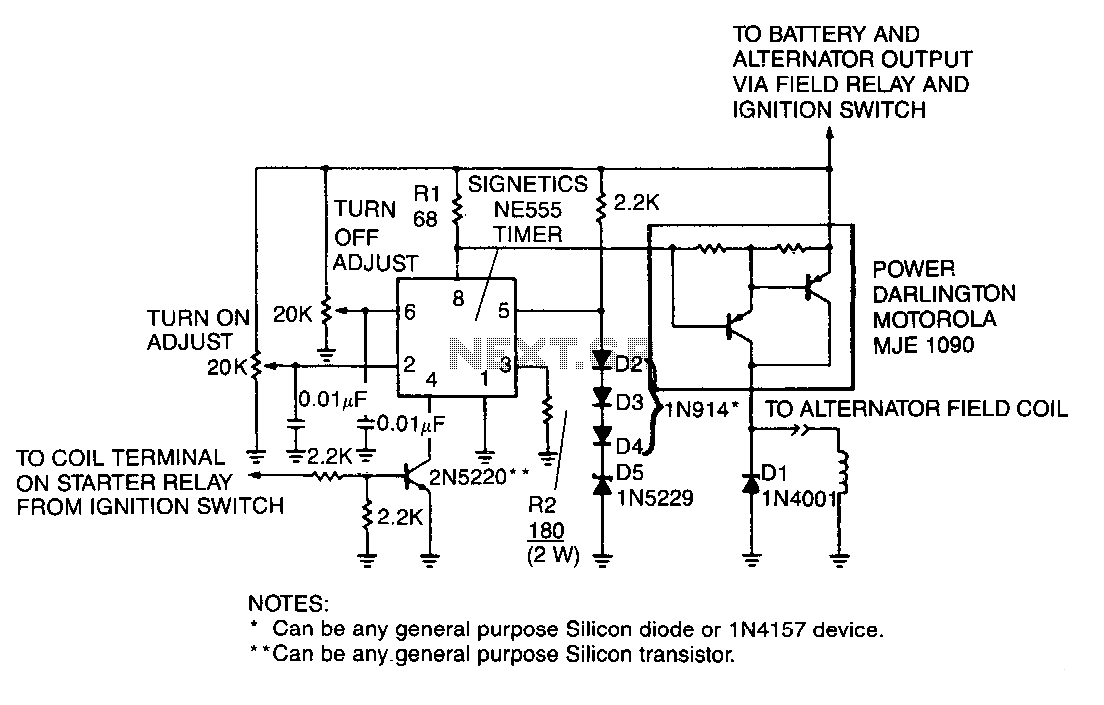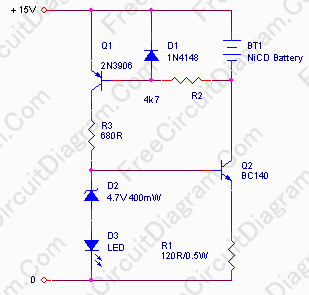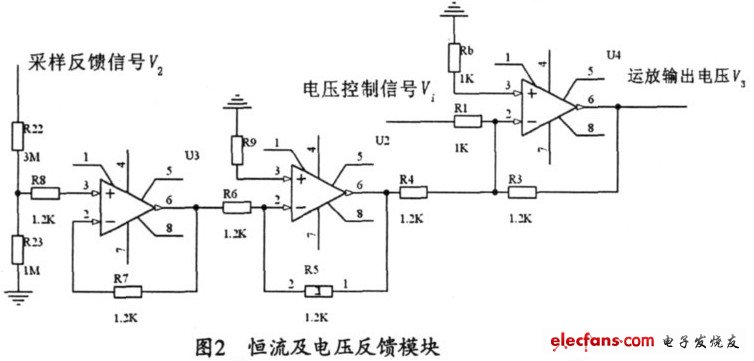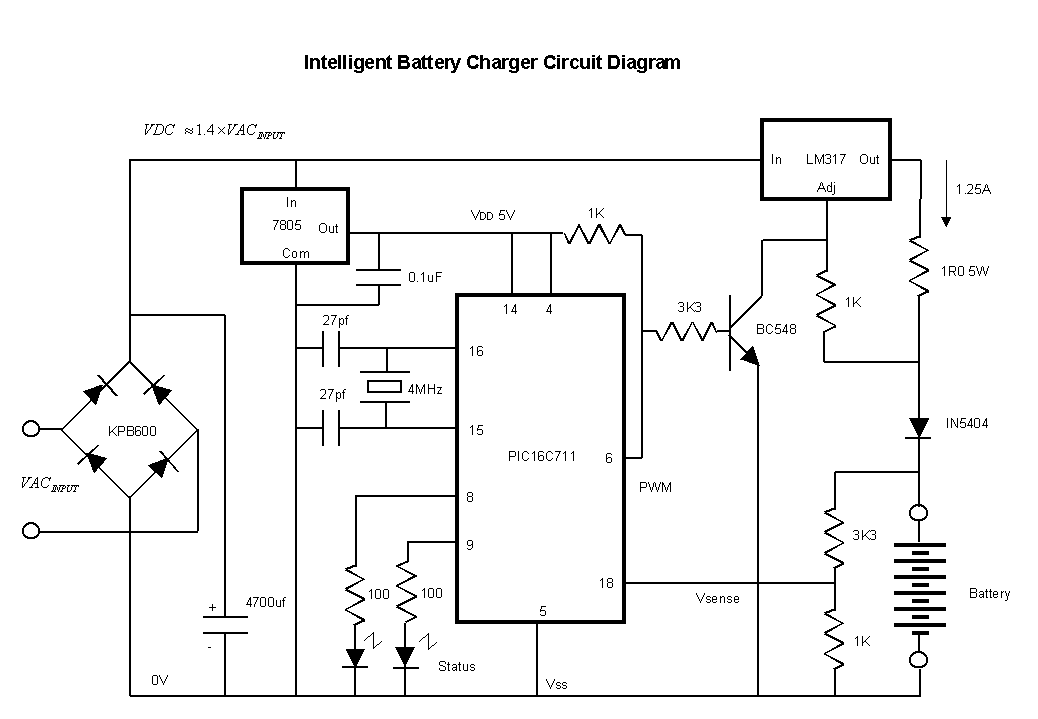
nicd charger with current and voltage limiting
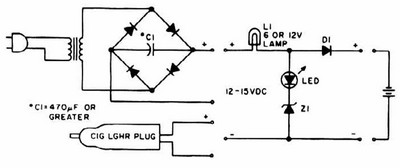
NiCd charger with current and voltage limiting power supply. This is a car NiCd battery charger circuit that can charge any Ni-Cd battery between 4.8 and 4.4 volts from a classic 12 volts car battery. The charging current can be selected from the values of 50 to 120 mA using the selector switch. This feature is particularly useful for model-making enthusiasts, video operators, and those who use small appliances for transmission and reception, as well as for anyone who uses Ni-Cd batteries and requires recharging when a voltage network is unavailable.
The described NiCd charger circuit is designed to efficiently charge nickel-cadmium batteries with a specific voltage range of 4.4 to 4.8 volts, utilizing a standard 12-volt automotive battery as a power source. The circuit integrates a current and voltage limiting mechanism to ensure safe and effective charging, thereby preventing damage to the battery due to overcharging.
In this configuration, the charging current is adjustable between 50 mA and 120 mA through a selector switch (S). This adjustability allows users to tailor the charging rate according to the specific requirements of different NiCd batteries and applications. For instance, a lower charging current may be preferable for smaller batteries or to extend battery life, while a higher current may be used for quicker charging of larger capacities.
The circuit typically includes essential components such as a transformer to step down the voltage, a rectifier to convert AC to DC, and a voltage regulator to maintain a stable output voltage. Additionally, protection diodes may be implemented to prevent reverse current flow, ensuring the longevity of both the charger and the batteries being charged.
This charger is particularly advantageous for users in remote areas or situations where access to standard electrical outlets is limited. Its application spans various fields, including model making, video production, and any other scenarios where portable power solutions are necessary. The design emphasizes user-friendliness and adaptability, making it a valuable tool for individuals reliant on NiCd batteries.NiCd Charger with Current and Voltage Limiting power supply. Go to that page to read the explanation about above power supply related circuit diagram. This is a car nicd battery charger circuitthat can chargeanyNi-Cdbatterybetween 4. 8 and4. 4 voltsfromaclassic12Voltscar battery. Thecharging currentis constan titcan beselected from the values of 50 to120mAbythe selectorS. This feature is veryuseful formodel makingenthusiasts, forvideooperators, to those who usesmall appliancestransmissionandreceptionto all thosethat useNi-Cdbatteriesand needto rechargeorvoltagenetworkis not available. . 🔗 External reference
The described NiCd charger circuit is designed to efficiently charge nickel-cadmium batteries with a specific voltage range of 4.4 to 4.8 volts, utilizing a standard 12-volt automotive battery as a power source. The circuit integrates a current and voltage limiting mechanism to ensure safe and effective charging, thereby preventing damage to the battery due to overcharging.
In this configuration, the charging current is adjustable between 50 mA and 120 mA through a selector switch (S). This adjustability allows users to tailor the charging rate according to the specific requirements of different NiCd batteries and applications. For instance, a lower charging current may be preferable for smaller batteries or to extend battery life, while a higher current may be used for quicker charging of larger capacities.
The circuit typically includes essential components such as a transformer to step down the voltage, a rectifier to convert AC to DC, and a voltage regulator to maintain a stable output voltage. Additionally, protection diodes may be implemented to prevent reverse current flow, ensuring the longevity of both the charger and the batteries being charged.
This charger is particularly advantageous for users in remote areas or situations where access to standard electrical outlets is limited. Its application spans various fields, including model making, video production, and any other scenarios where portable power solutions are necessary. The design emphasizes user-friendliness and adaptability, making it a valuable tool for individuals reliant on NiCd batteries.NiCd Charger with Current and Voltage Limiting power supply. Go to that page to read the explanation about above power supply related circuit diagram. This is a car nicd battery charger circuitthat can chargeanyNi-Cdbatterybetween 4. 8 and4. 4 voltsfromaclassic12Voltscar battery. Thecharging currentis constan titcan beselected from the values of 50 to120mAbythe selectorS. This feature is veryuseful formodel makingenthusiasts, forvideooperators, to those who usesmall appliancestransmissionandreceptionto all thosethat useNi-Cdbatteriesand needto rechargeorvoltagenetworkis not available. . 🔗 External reference
